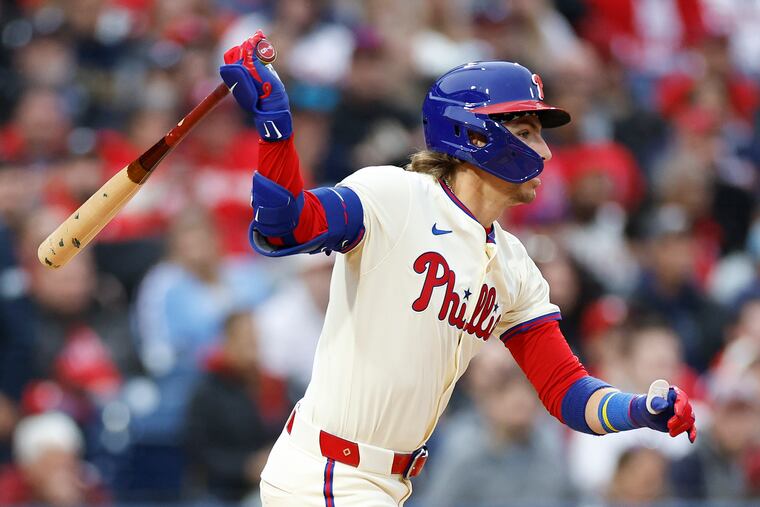The Phillies are chasing less but are they being too tentative? ‘There’s something to that.’
The Phillies, who have several free swingers, sought improvement in plate discipline. Did they overcompensate after five bad NLCS games?

Before the Phillies played in St. Louis the other day, Rob Thomson sat in the visiting manager’s office and recalled seeing clips of Derek Jeter as a high schooler in Michigan and Xander Bogaerts as a teenager in Aruba.
“Exact same swing,” Thomson said, “that they had when they got to the big leagues.”
Thomson brought this up after the Phillies’ youngest player suggested that his approach at the plate has sometimes felt, well, at odds, with the organization’s emphasis on swinging at fewer pitches outside the strike zone — “chasing,” in hitting parlance.
» READ MORE: As load management creeps into MLB, these Phillies want to play every day: ‘It’s a mindset’
It also relates to an early-season question that has arisen internally: Has all the focus on reducing chase rates caused some Phillies hitters to be too tentative about attacking pitches that are actually in the zone?
“There’s something to that,” Thomson said. “It’s like running the bases. You tell guys, ‘Don’t get thrown out on the bases,’ well, they just stop running. Same thing with chasing. If you’re so focused on not chasing instead of being aggressive in the zone, then they’re probably not going to swing [as much].”
OK, let’s pause. The Phillies swung at a higher percentage of pitches out of the zone (31.3%) than only three teams last season. In 2022, they tied for the fourth-highest chase rate (30.9%). Many of their most productive hitters are free swingers. It’s baked into their DNA.
All this talk of chasing didn’t come up until everything crashed down in Game 7 of the National League Championship Series. Nobody exploited the Phillies’ weakness as well as the Diamondbacks — and even they didn’t execute enough pitches to truly take advantage until Game 3 in Arizona.
The Phillies had neither the desire nor the flexibility within a $260 million luxury-tax payroll to change the types of hitters in the lineup. But they did hire two coaches to assist hitting coach Kevin Long in implementing drills and analyzing data that might help some of those hitters make a few better swing decisions.
Has it worked? Like everything else about baseball in April, it’s too soon to form judgments. But through 12 games — minuscule sample alert! — the Phillies clipped their chase rate to 28.8%. Nick Castellanos was down to 38.1% from a career-high 41% last year; Trea Turner: 24.8%, from 35.3%, also a career high; Bryson Stott: 28.2%, from 29.5%.
Join Inquirer Phillies reporter Scott Lauber for a subscriber exclusive event featuring Phillies legend Larry Bowa at the Fitler Club on April 18 at 6 p.m.! Hear Bowa share his insider stories and insights from his incredible 59-year baseball career. This is an exclusive opportunity you won’t want to miss! Register here.
But here’s the thing: Castellanos, typically a doubles machine, didn’t have an extra-base hit yet. Stott’s average exit velocity and hard-hit rate were down, with Thomson noting that his hardest contact was to the opposite field, a sign that he wasn’t hitting the ball out in front as often as usual.
As a team, the Phillies ranked 25th in average exit velocity (87.9 mph) and 21st in hard-hit rate (37.4%).
The caveat always applies: Early in the season, data can be more random than informative. Anecdotally, though, some hitters believe the numbers align with how they’re feeling at the plate.
» READ MORE: Brandon Marsh's 'great at-bats' continue in Phillies' series in St. Louis
To wit: After notching three hits, including a hard-hit double to left field on an aggressive swing, Monday night in St. Louis, young center fielder Johan Rojas indicated that the focus on chasing less caused him to be tentative in the strike zone.
“I think that I was a little shy at the plate before,” he said through a team interpreter. “Right now, what I can do is be myself and help the team win.”
A day later, Castellanos told reporters that he’s “wanting so much to just swing at good pitches that I feel like I lost the whippiness and the looseness that I had attacking the ball.”
» READ MORE: Phillies vs. Braves: Who’s chasing whom? The subplots that make up baseball’s best rivalry.
So, would the Phillies consider advising a hitter, especially a veteran such as Castellanos, to worry less about chasing?
“I think you work certain drills prior to the game to try to eliminate chase, but once the game starts, you’ve got to go play,” Thomson said. “You’ve got to go play baseball. And hopefully the drill work passes into the game.”
To be fair, the Phillies didn’t set out to proselytize their free swingers. Early in the offseason, in fact, president of baseball operations Dave Dombrowski said “some hitters, you can talk to them a lot, and they’re still going to chase.”
But given their extreme roster continuity after winning 90 games last season and coming within one victory of another pennant, the Phillies have sought marginal improvements in many areas, including plate discipline.
Did they overcompensate after five bad games at the worst possible time? Or maybe there isn’t enough evidence in a 12-game snapshot to draw any meaning to conclusion.
Thomson isn’t opposed to guarding against the former. Because most established hitters that he has seen — be they Bogaerts or Jeter, Castellanos or Turner — don’t usually change their stripes, and the Phillies’ lineup is filled with established hitters.
“We have to be careful sometimes,” Thomson said. “Because we talk about, ‘Don’t chase, don’t chase, don’t chase.’ You want to have balance there, because you want to maintain your aggression in the strike zone.”
» READ MORE: Murphy: Pitching injuries are easy to explain, hard to accept. The cost of doing business.